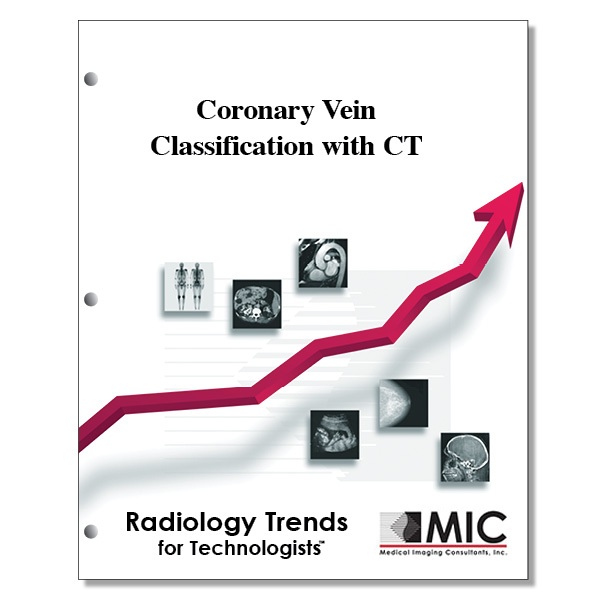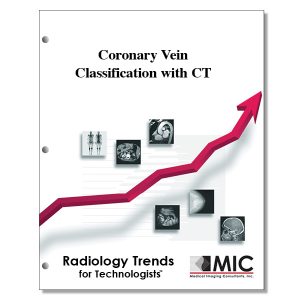

Coronary Vein Classification with CT
The role of coronary CT angiography is presented in the anatomic classification, assessment of anatomic variants, and pathologic changes in the coronary venous system.
Course ID: Q00347 Category: Radiology Trends for Technologists Modalities: Cardiac Interventional, CT, Nuclear Medicine4.25 |
Satisfaction Guarantee |
$39.00
- Targeted CE
- Outline
- Objectives
Targeted CE per ARRT’s Discipline, Category, and Subcategory classification:
[Note: Discipline-specific Targeted CE credits may be less than the total Category A credits approved for this course.]
Cardiac-Interventional Radiography: 4.25
Procedures: 4.25
Diagnostic and Conduction System Studies: 4.25
Computed Tomography: 4.25
Procedures: 4.25
Neck and Chest: 4.25
Nuclear Medicine Technology: 1.50
Procedures: 1.50
Cardiac Procedures: 1.50
Registered Radiologist Assistant: 4.25
Procedures: 4.25
Thoracic Section: 4.25
Outline
- Introduction
- Development of the Cardiac Veins
- Cardiac Vein Classification
- Lesser CVS (Thebesian Vessels
- Conduction System
- Papillary Muscles
- Venoluminal Thebesian Vessels
- Atrial Venous System
- Veins of the LA Wall
- Veins of the RA Wall
- Anterior Right Ventricular Venous System
- Anterior Cardiac Veins
- Right Marginal Vein
- Conus (Infundibular) Veins
- CS Tributaries
- Imaging Methods
- Great Cardiac Vein
- Inferior Interventricular Vein
- Left Posterior (Postero-lateral) and Left Marginal Veins
- Small Cardiac Vein
- Oblique Vein of the LA (Vein of Marshall
- Ventricular Septal Veins
- Valves of Coronary Veins
- CS Boundaries
- Phasic Variation of the Coronary Veins
- Coronary Veins and Congenital Heart Disease
- Cardiac Resynchronization Therapy
- CS Interatrial Muscle Connections
- Percutaneous Mitral Annuloplasty
- RCP Delivery from the CS
- Conclusions
Objectives
Upon completion of this course, students will:
- understand the role of coronary veins in the treatment of structural heart disease and malignant ventricular tachyarrhythmia
- understand the importance of cardiac venous mapping prior to an invasive cardiac procedure
- be familiar with diagnostic imaging procedures used to visualize the cardiac venous system
- understand the vessels which make up the cardiac circulation
- be familiar with the various layers of the heart
- understand the embryological development of the cardiac venous system
- be familiar with the role the cardinal vein plays in the cardiac venous system’s stages of development
- be familiar with the two major classes of cardiac veins
- understand what the term compound cardiac venous system means
- be familiar with the cardiac venous drainage pathways of the cardiac ventricles and atriums
- understand the thebesian vessels and their role
- be familiar with the four distinct parts of the thebesian vessel system
- understand the meaning of vessel sinusoids
- understand the role of the sinoatrial node in the cardiac conduction system
- understand the role of the atrioventricular node in the cardiac conduction system
- understand the role of the papillary muscles in the cardiac system
- be familiar with the three main groups of left atrial wall veins and their drainage pathways
- be familiar with the three main groups of right atrial wall veins and their drainage pathways
- be familiar with the von Lüdinghausen classification of the cardiac atrial venous system
- be familiar with the role of the anterior right ventricular cardiac veins and their drainage pathways
- understand the anatomy that surrounds the coronary sinus
- understand the role the coronary sinus plays in invasive cardiac interventional procedures
- understand the role the coronary sinus plays in the cardiac conduction system
- be familiar with the challenges to imaging the heart using diagnostic procedures
- be familiar with the contrast injection techniques pertaining to CT angiography
- understand the advantages of MDCT coronary angiography compared to other procedures
- understand the disadvantages of MDCT coronary angiography compared to other procedures
- be familiar with the various planes and projections used with MDCT angiography
- know why the levophase of coronary venography is important
- be familiar with dose reduction techniques that may be used in MDCT coronary angiography
- be familiar with the pre- and post-processing techniques used with MDCT coronary angiography data
- understand the benefits of volume rendering with MDCT for the cardiac venous system
- understand the “gold standard” for visualizing the cardiac venous system
- be familiar with the techniques that are used for retrograde venography
- identity the standard projections taken during a retrograde venography procedure
- understand the pitfalls and disadvantages of retrograde venography
- be familiar with the cardiac veins near the coronary sinus and their role
- be familiar with the cardiac veins of the walls of the left ventricle and their drainage pathways
- be familiar with imaging the oblique vein of Marshall
- be familiar with the various types of venous valves
- be familiar with the benefits of cardiac resynchronization therapy
- be familiar with congenital cardiac lesions associated with coronary sinus atresia and a left superior vena cava
- understand the benefits of percutaneous mitral annuloplasty
- identify patients who may not be candidates for percutaneous mitral annuloplasty
- identify the benefits of retrograde cardioplegia perfusion
